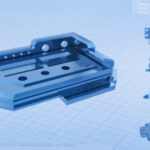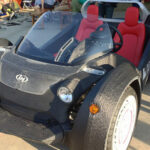An important aspect of road safety is to ensure that vehicles are seen by other motorists in dark, foggy scenarios. This is where the necessity of front and rear lights comes into play. In order to ensure road safety for vehicles, the headlights have to be regularly checked and correctly aimed by professionals. These need to have a transparent surface and be visible from a distance. Of course, vehicle headlights are of vital importance when it comes to car manufacturing. For the manufacture of Ford Trucks, 3E Rapid Prototyping took up the challenge of 3D printing some components that were just right. The special front and rear lights that were printed out were found to be safer as they had better visibility when tested out.
3ERP has been providing a wide range of additive manufacturing, 3D printing, and rapid prototyping service solutions to various industries. In addition to their specialization in vacuum casting, CNC machining, sheet metal prototype formation, model finishing, and injection molding, 3ERP also has valuable experience in the lighting manufacturing for the auto sector. They have made some state of the art lighting prototypes for some industry leaders of the automotive manufacturers and designers. When the Ford Truck project came in, they were excited to see what possibilities and innovations they could develop.
The Ford Truck Project
The components that were constructed were the external lighting i.e., head and tail lights of cars and trucks. Like most light guides, these too had to be transparent and clearly visible to on the road motorists from a distance. Also, the material had to be suitable for 3D printing. Therefore, the material of choice for the transparent light guide was PMMA- used in the tail lamp of the car. There were aluminum parts that acted as reflectors for the tail lamp of the vehicles. PMMA softens at about 73 degrees Celsius and tends to burn without leaving any residue at temperatures higher than 700 degrees Celsius.
The main challenge, however, was printing out the yellow parts out of the ABS plastic, which have various structural components essential for the assembly of a tail lamp of a truck. The yellow ABS component was something the team found a little out of the box and innovative, yet they decided to take on the challenge of working with ABS. For the most part, the greatest obstacle in working with ABS in 3D printing is its tendency to curl upwards where it is in direct contact with the printer’s print bed. When it comes to eliminating this issue, precision in heating the print surface and ensuring a flat, smooth, and clean finish can help a lot. For this, a mixture of ABS and Acetone is popularly used in order to prep the print surface beforehand.
In contact with moisture, however, ABS runs the risk of bubbling or spurting from the printer nozzle tip, which can potentially reduce the part accuracy, visual quality, strength, and can even introduce the risk of clogging or stripping in the printer nozzle. Due to these reasons, ABS or Acrylonitrile Butadiene Styrene can be very tricky to work with.
As a polymer material, it can take up many forms and can be altered to have many interesting properties. The strong plastic has mild flexibility compared to its other popular counterpart, PLA. Before adding the yellow color for the lights, natural ABS had a milky beige color. Due to the flexibility of ABS, it is easy to create interlocking or pin connected pieces, the material being easily machined and sanded. Some of its other great advantages lie in its flexibility, high resistance to temperature, machinability, etc., which make it a preferred choice for engineers. Also, compared to other plastics, ABS is easier to recycle, providing for more eco friendly vehicle headlights!
In order to build the lights, the parts were first of all split up in specialized CAD software. After rigorous machining on a number of 3 axis machines, the parts were ready to be assembled. They were then glued together with precision and skill. Due to this method of 3D printing, loss of materials can be prevented effectively. Compared to a normal assembly line production, a lot of materials can be saved, resulting in accurate part designs and good surface finishes. Also, instead of using 4 or 5 axis machines, the majority of parts were easily made with 3 axis machines. This eliminates the need of many complex processes.
The Automotive Industry
This is just one of the examples where 3D printing or additive manufacturing is bringing in a revolution in the automotive industry. This technology can significantly save time and money for the restoration and customization of vehicles. This is the reason why large auto manufacturing corporations have started to incorporate 3D printing into their production lines. The vehicle head and tail lights manufactured in this process took a shorter time and were an exact fit onto the Ford Trucks. Getting custom made die for a single part can prove very costly, which can be lowered by the cheaper and faster produced parts using FDM technology.
The end result was a higher performing and safer light for Ford Trucks. So the next time you are driving home on a dark or foggy night and you see a bright light shining from a truck, it just be this special light manufactured by 3E Rapid Prototyping. Drive safe and keep your eyes on the road and off your phone.





